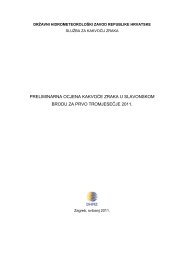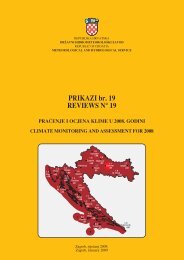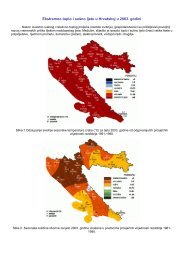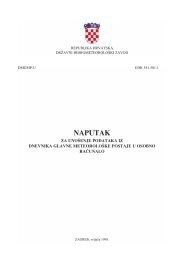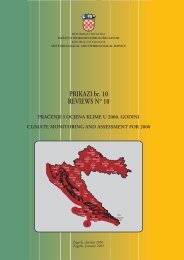CROATIAN CLIMATE OBSERVING SYSTEM
CROATIAN CLIMATE OBSERVING SYSTEM
CROATIAN CLIMATE OBSERVING SYSTEM
You also want an ePaper? Increase the reach of your titles
YUMPU automatically turns print PDFs into web optimized ePapers that Google loves.
<strong>CROATIAN</strong> <strong>CLIMATE</strong> <strong>OBSERVING</strong> <strong>SYSTEM</strong> 15<br />
Meteorological and Aerological Observatory, Zagreb-Maksimir<br />
with automatic and conventional observations, MHS, Croatia<br />
- Climatological (standard meteorological) stations carry out observations at 07, 14 and<br />
21 hrs mean local time and monitor meteorological phenomena during the day.<br />
Observations are performed by non-professional observers and the stations are usually<br />
situated on private land. Some of these stations forward public information data by phone,<br />
once or twice a day. At the end of each month, observation logs are forwarded by mail to<br />
MHS, where the data are entered into computers, controlled and stored. These data are<br />
used directly or via user programmes.<br />
Station spatial distribution meets WMO requirements.<br />
- Precipitation stations measure precipitation amounts at 7h a.m. (Mean European<br />
Time) every day (for preceded 24 h) and make weather phenomena observation during 24<br />
h. Observation are performed by non profesional observers and the stations are situated<br />
on private land. At the end of each month, observation logs are forwarded by mail to<br />
MHS, where the data are entered into computers, controlled and stored. This data are<br />
used directly or via user programmes.<br />
- Storage rain-gauges are rain gauges collecting precipitation over longer periods. They<br />
are usually located in inaccessible areas, away from human settlements, and are emptied<br />
once a year.<br />
Spatial distribution does not meet the necessary requirements and needs improving.<br />
- Automatic meteorological stations transferring data to the MHS IT system have been set<br />
up at all surface main meteorological stations and at other locations required by users,<br />
and are part of the MHS IT system. They measure one or more variables, depending on<br />
available funds and user requirements. Data from these stations are available for operational<br />
use and are regularly controlled and stored.<br />
In the future, the meteorological station network should be further automated.



